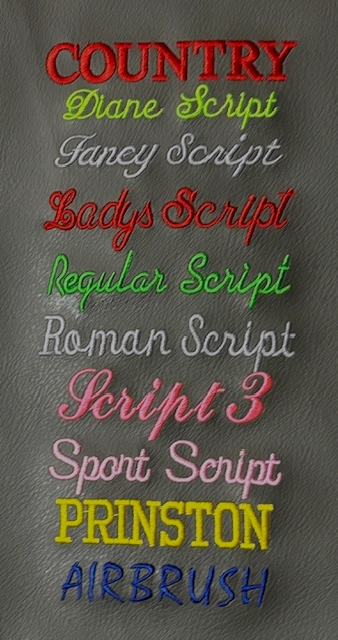The Art of Custom-made Needlework: Opening the Tricks to Creating Distinct and Remarkable Styles
Needlework, a craft soaked in tradition and creativity, holds within its intricate stitches the power to transform textile right into a canvas of distinct expression. The keys to creating personalized embroidery layouts that mesmerize the eye and leave a lasting impression depend on a fragile equilibrium of technique, imagination, and focus to information. As we delve into the world of personalized embroidery, we reveal the nuanced interplay between string choice, stitch complexity, and style personalization that boosts a simple garment to a job of art. Join us on a journey through the art of customized embroidery as we unwind the mysteries behind crafting genuinely remarkable and distinct creations.
Picking the Right Needlework Threads
When choosing needlework threads, what essential elements should you consider to make sure the most effective results for your personalized styles? The choice of needlework thread is critical in establishing the last end result of your embroidered layout. Among the primary factors to consider is the material of the string. Different products such as cotton, polyester, rayon, and silk provide varying degrees of shine, longevity, and structure. It is vital to pick a thread product that complements the textile you are embroidering on and straightens with the desired look of the layout.
Thicker strings can include dimension and structure to your style, while finer strings are excellent for intricate details and small text. Additionally, thinking about the color fastness and washability of the thread is important to make certain that your custom layouts keep their top quality and vibrancy over time.
Discovering Various Stitch Strategies
To dive right into the world of 'Discovering Various Stitch Strategies', one have to understand the ins and outs and nuances that each stitching method brings to the art of needlework. Various stitch strategies not just add visual interest but also add to the total appearance and measurement of the layout. One preferred stitch technique is the satin stitch, which involves very closely stuffed parallel stitches to develop a smooth and shiny surface area, perfect for filling out shapes and creating bold outlines.
On the various other hand, the backstitch is a functional strategy commonly utilized for outlining and including great details. It involves sewing backwards to create a strong line of embroidery. Additionally, the French knot stitch includes a tactile element to layouts, best for creating distinctive accents like flower centers or attractive touches.
Checking out different stitch strategies enables embroiderers to have fun with light, darkness, and depth within their layouts, elevating the aesthetic charm and artistic top quality of their embroidery jobs. By grasping various stitching methods, one can open endless opportunities for developing distinct and memorable custom-made embroidery items.
Incorporating Personalized Layout Aspects
Having actually explored the ins and outs of various stitch techniques such as the satin stitch, backstitch, and French knot, the link focus currently changes towards incorporating individualized layout elements in customized needlework projects. Customized layout elements play a critical role in making embroidery tasks truly special and memorable.
An additional means to include tailored style components is by consisting of symbols or motifs that hold special significance to the recipient or mirror their passions and personality. As an example, integrating a favored blossom, pet, or hobby-related symbol can make the embroidery style a lot more meaningful and personalized. Furthermore, selecting colors that resonate with the recipient or line up with the desired style can additionally improve the personalization of the embroidery project.
Mastering the Art of Shade Control

One secret aspect of color sychronisation is comprehending color theory. This includes knowing how different colors communicate with each various other, the feelings they share, and just how they can be incorporated to develop visually appealing designs. By applying color theory principles, embroiderers can create harmonious color palettes that enhance the overall look of the design.
Additionally, taking notice of contrast is important in color sychronisation. Using contrasting colors can help certain elements of the design pop, improve legibility, and create an aesthetically vibrant needlework item. By grasping the art of color sychronisation, embroiderers can elevate their designs and create memorable items that reverberate with customers and customers alike.
Enhancing Structure With Advanced Embroidery Stitches
French knots, for instance, are best for including little, increased dots to your style, simulating the appearance of grains or producing a distinctive surface area. Bullion knots, on the other hand, can be utilized to produce twisted, ropelike aspects that add a glamorous feeling to the embroidery. Seed sewing involves tiny, scattered stitches that can fill in areas with a multicolor texture, while turkey work creates cosy, dimensional accents evocative pet hair or foliage. Trying out Visit Website these advanced embroidery stitches permits you to press the limits of standard embroidery and create truly one-of-a-kind and aesthetically attractive structures in your designs.
Verdict
Finally, the art of custom-made embroidery includes a mix of selecting the best strings, checking out different stitch techniques, integrating personalized layout elements, understanding color control, and improving appearance with advanced stitches. By recognizing and carrying out these key components, embroiderers can create one-of-a-kind and memorable styles that display their creativity and ability. Embroidery enthusiasts can unlock the keys to creating attractive and bespoke items that stand out and leave an enduring impression.